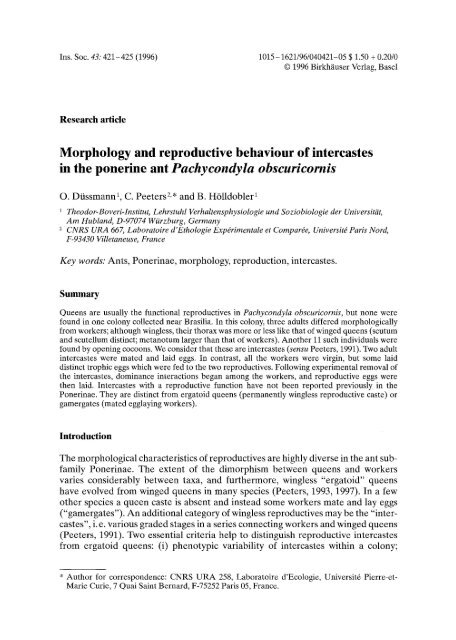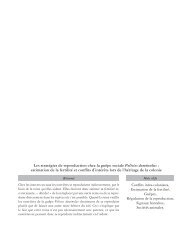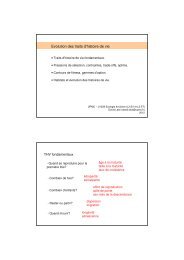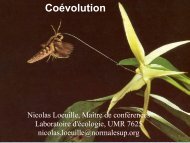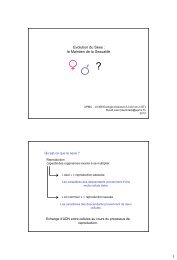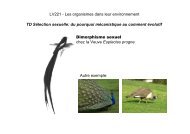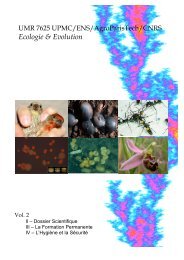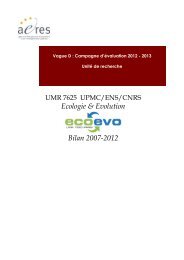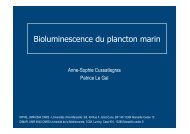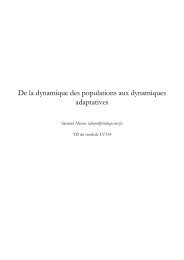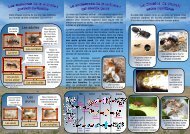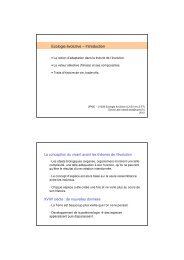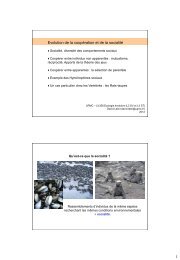Morphology and reproductive behaviour of intercastes in the ...
Morphology and reproductive behaviour of intercastes in the ...
Morphology and reproductive behaviour of intercastes in the ...
You also want an ePaper? Increase the reach of your titles
YUMPU automatically turns print PDFs into web optimized ePapers that Google loves.
Ins. Soc. 43:421-425 (1996) 1015-1621/96/040421-05 $1.50 + 0.20/0<br />
9 1996 Birkhfiuser Verlag, Basel<br />
Research article<br />
<strong>Morphology</strong> <strong>and</strong> <strong>reproductive</strong> <strong>behaviour</strong> <strong>of</strong> <strong><strong>in</strong>tercastes</strong><br />
<strong>in</strong> <strong>the</strong> poner<strong>in</strong>e ant Pachycondyla obscuricornis<br />
O. Dtissmann ~, C. Peeters 2,* <strong>and</strong> B. H611dobler 1<br />
1 Theodor-Boveri-Institut, Lehrstuhl Verhaltensphysiologie und Soziobiologie der Universitiit,<br />
Am Hubl<strong>and</strong>, D-97074 Wiirzburg, Germany<br />
z CNRS URA 667, Laboratoire d'Ethologie Expdrimentale et Compar~e, Universit~ Paris Nord,<br />
F-93430 Villetaneuse, France<br />
Key words: Ants, Poner<strong>in</strong>ae, morphology, reproduction, <strong><strong>in</strong>tercastes</strong>.<br />
Summary<br />
Queens are usually <strong>the</strong> functional <strong>reproductive</strong>s <strong>in</strong> Pachycondyla obscuricornis, but none were<br />
found <strong>in</strong> one colony collected near Brasilia. In this colony, three adults differed morphologically<br />
from workers; although w<strong>in</strong>gless, <strong>the</strong>ir thorax was more or less like that <strong>of</strong> w<strong>in</strong>ged queens (scutum<br />
<strong>and</strong> scutellum dist<strong>in</strong>ct; metanotum larger than that <strong>of</strong> workers). Ano<strong>the</strong>r 11 such <strong>in</strong>dividuals were<br />
found by open<strong>in</strong>g cocoons. We consider that <strong>the</strong>se are <strong><strong>in</strong>tercastes</strong> (sensu Peeters, 1991). Two adult<br />
<strong><strong>in</strong>tercastes</strong> were mated <strong>and</strong> laid eggs. In contrast, all <strong>the</strong> workers were virg<strong>in</strong>, but some laid<br />
dist<strong>in</strong>ct trophic eggs which were fed to <strong>the</strong> two <strong>reproductive</strong>s. Follow<strong>in</strong>g experimental removal <strong>of</strong><br />
<strong>the</strong> <strong><strong>in</strong>tercastes</strong>, dom<strong>in</strong>ance <strong>in</strong>teractions began among <strong>the</strong> workers, <strong>and</strong> <strong>reproductive</strong> eggs were<br />
<strong>the</strong>n laid. Intercastes with a <strong>reproductive</strong> function have not been reported previously <strong>in</strong> <strong>the</strong><br />
Poner<strong>in</strong>ae. They are dist<strong>in</strong>ct from ergatoid queens (permanently w<strong>in</strong>gless <strong>reproductive</strong> caste) or<br />
gamergates (mated egglay<strong>in</strong>g workers).<br />
Introduction<br />
The morphological characteristics <strong>of</strong> <strong>reproductive</strong>s are highly diverse <strong>in</strong> <strong>the</strong> ant sub-<br />
family Poner<strong>in</strong>ae. The extent <strong>of</strong> <strong>the</strong> dimorphism between queens <strong>and</strong> workers<br />
varies considerably between taxa, <strong>and</strong> fur<strong>the</strong>rmore, w<strong>in</strong>gless "ergatoid" queens<br />
have evolved from w<strong>in</strong>ged queens <strong>in</strong> many species (Peeters, 1993, 1997). In a few<br />
o<strong>the</strong>r species a queen caste is absent <strong>and</strong> <strong>in</strong>stead some workers mate <strong>and</strong> lay eggs<br />
("gamergates"). An additional category <strong>of</strong> w<strong>in</strong>gless <strong>reproductive</strong>s may be <strong>the</strong> "<strong>in</strong>ter-<br />
castes", i. e. various graded stages <strong>in</strong> a series connect<strong>in</strong>g workers <strong>and</strong> w<strong>in</strong>ged queens<br />
(Peeters, 1991). Two essential criteria help to dist<strong>in</strong>guish <strong>reproductive</strong> <strong><strong>in</strong>tercastes</strong><br />
from ergatoid queens: (i) phenotypic variability <strong>of</strong> <strong><strong>in</strong>tercastes</strong> with<strong>in</strong> a colony;<br />
* Author for correspondence: CNRS URA 258, Laboratoire d'Ecologie, Universit6 Pierre-et-<br />
Marie Curie, 7 Quai Sa<strong>in</strong>t Bernard, F-75252 Paris 05, France.
422 Dfissmann et al.<br />
(ii) coexistence <strong>of</strong> <strong>reproductive</strong> <strong><strong>in</strong>tercastes</strong> <strong>and</strong> w<strong>in</strong>ged queens, while ergatoid<br />
queens occur <strong>in</strong>stead <strong>of</strong> w<strong>in</strong>ged queens.<br />
In Pachycondyla obscuricornis (tribe Poner<strong>in</strong>i), w<strong>in</strong>ged queens are <strong>the</strong> functio-<br />
nal <strong>reproductive</strong>s <strong>and</strong> exhibit limited morphological divergence from workers<br />
(Fresneau, 1984; Oliveira <strong>and</strong> HOlldobler, 1991). We report that <strong><strong>in</strong>tercastes</strong> exist<br />
<strong>and</strong> are also able to mate <strong>and</strong> reproduce.<br />
Material <strong>and</strong> methods<br />
The s<strong>in</strong>gle colony described here was collected by E Oliveira <strong>in</strong> "cerrado" (transi-<br />
tion between tropical forest <strong>and</strong> semi-arid vegetation) near Brasilia (Brazil) <strong>in</strong> July<br />
1992. About 100 workers <strong>and</strong> eggs were found, but no queen. We observed <strong>the</strong><br />
colony <strong>in</strong> 1993, at which time 50 adults were present. Forty cocoons were opened to<br />
exam<strong>in</strong>e <strong>the</strong> morphology <strong>of</strong> pupae. All adults were <strong>in</strong>dividually colour-marked <strong>and</strong><br />
observed directly for 32 hours (with additional video monitor<strong>in</strong>g). The thoracic<br />
morphology <strong>of</strong> adults was studied with SEM. Ovaries <strong>and</strong> sperma<strong>the</strong>cae were dis-<br />
sected to determ<strong>in</strong>e <strong>reproductive</strong> status. Voucher specimens have been deposited <strong>in</strong><br />
<strong>the</strong> Natural History Museum <strong>in</strong> London.<br />
Results<br />
<strong>Morphology</strong><br />
Three female adults differed morphologically from workers; although w<strong>in</strong>gless,<br />
<strong>the</strong>ir thoracic structure was more or less like that <strong>of</strong> a w<strong>in</strong>ged queen (mesonotum<br />
differentiated <strong>in</strong>to scutum <strong>and</strong> scutellum; metanotum larger than <strong>in</strong> workers;<br />
Fig. 1), <strong>and</strong> <strong>the</strong>y had three ocelli. Eleven partly pigmented pupae also exhibited a<br />
similar comb<strong>in</strong>ation <strong>of</strong> queen <strong>and</strong> worker characters (Fig. 2). We consider that <strong>the</strong>y<br />
are "<strong><strong>in</strong>tercastes</strong>" (sensu Peeters, 1991). Two <strong>of</strong> <strong>the</strong> adult <strong><strong>in</strong>tercastes</strong> differed from<br />
<strong>the</strong> third <strong>in</strong> body size <strong>and</strong> <strong>in</strong> <strong>the</strong> relative shape <strong>of</strong> thoracic sclerites; <strong>in</strong>tercaste pupae<br />
exhibited similar variability (Fig. 2). However we could not measure <strong>the</strong> pupae<br />
accurately, <strong>and</strong> a bigger sample <strong>of</strong> adults is needed to document with<strong>in</strong>-colony<br />
variation <strong>in</strong> size.<br />
Reproduction<br />
Two <strong>of</strong> <strong>the</strong> three adult <strong><strong>in</strong>tercastes</strong> were mated <strong>and</strong> laid <strong>reproductive</strong> eggs. Each had<br />
a pair <strong>of</strong> three developed ovarioles, with dark yellow bodies occurr<strong>in</strong>g basally. The<br />
unmated <strong>in</strong>tercaste (which was smaller) was sterile, but her sperma<strong>the</strong>ca was similar<br />
<strong>in</strong> size to <strong>the</strong> o<strong>the</strong>rs.<br />
All <strong>the</strong> workers were virg<strong>in</strong>. Their sperma<strong>the</strong>cae were smaller, <strong>and</strong> <strong>the</strong>refore<br />
may not be functional. Some workers also exhibited ovarian activity (<strong>the</strong>ir six ova-<br />
rioles were shorter than <strong><strong>in</strong>tercastes</strong>'), but <strong>the</strong>y laid only trophic eggs (dist<strong>in</strong>ct <strong>in</strong><br />
shape, <strong>and</strong> quickly ejected from <strong>the</strong> gaster). These were immediately given to
Reproductive <strong><strong>in</strong>tercastes</strong> <strong>in</strong> a poner<strong>in</strong>e ant 423<br />
Figure 1. Scann<strong>in</strong>g electron micrographs (dorsal view) <strong>of</strong> <strong>the</strong> alitrunk <strong>of</strong> P. obscuricornis: (a) dealate queen,<br />
(b) <strong>in</strong>tercaste, (c) worker. Note <strong>the</strong> relative proportions <strong>of</strong> thoracic sclerites. Scutum <strong>and</strong> scutellum <strong>of</strong> workers<br />
are fused. (a = pronotum; b = scutum; c = scutellum; d = mesonotum; e = metanotum)<br />
1%....j I<br />
Figure 2. Comparison <strong>of</strong> partly pigmented pupae <strong>of</strong> various castes, show<strong>in</strong>g <strong>the</strong> thoracic sclerites <strong>of</strong> a worker,<br />
a workerlike <strong>in</strong>tercaste, a queenlike <strong>in</strong>tercaste, <strong>and</strong> a w<strong>in</strong>ged queen
424 Dtissmann et al.<br />
ei<strong>the</strong>r one <strong>of</strong> <strong>the</strong> fertile <strong><strong>in</strong>tercastes</strong>, who ate <strong>the</strong>m. Thus, reproduction <strong>in</strong> this queen-<br />
less colony was monopolized by <strong>the</strong> two mated <strong><strong>in</strong>tercastes</strong>. They tended to rema<strong>in</strong><br />
near <strong>the</strong> eggs, but walked <strong>in</strong>side <strong>the</strong> nest frequently; <strong>the</strong>y never foraged.<br />
Experimental removal <strong>of</strong> <strong>the</strong> mated <strong><strong>in</strong>tercastes</strong> triggered <strong>the</strong> production <strong>of</strong><br />
male-dest<strong>in</strong>ed <strong>reproductive</strong> eggs by more than 10 workers.<br />
Dom<strong>in</strong>ance <strong>behaviour</strong><br />
Antennal box<strong>in</strong>g occurred whenever <strong>the</strong> two <strong>reproductive</strong> <strong><strong>in</strong>tercastes</strong> met, but<br />
nei<strong>the</strong>r reacted submissively, suggest<strong>in</strong>g that <strong>the</strong>y had equal status. Workers<br />
were never attacked, <strong>and</strong> <strong>the</strong>y did not exhibit aggression <strong>in</strong> <strong>the</strong> presence <strong>of</strong> <strong>the</strong><br />
<strong>reproductive</strong>s. However, when <strong>the</strong> <strong>reproductive</strong>s were removed, bit<strong>in</strong>g <strong>and</strong> jerk<strong>in</strong>g<br />
began among <strong>the</strong> workers. This aggression decreased <strong>in</strong> <strong>in</strong>tensity after one week.<br />
Viable eggs were laid by various high-rank<strong>in</strong>g workers, <strong>in</strong>dicat<strong>in</strong>g that dom<strong>in</strong>ance<br />
<strong>in</strong>teractions regulate ovarian activity. The unmated <strong>in</strong>tercaste had a low rank <strong>and</strong><br />
rema<strong>in</strong>ed sterile.<br />
When <strong>the</strong> <strong>reproductive</strong> <strong><strong>in</strong>tercastes</strong> were re-<strong>in</strong>troduced (<strong>the</strong>y had been isolated<br />
with a few workers for 4 weeks, <strong>and</strong> cont<strong>in</strong>ued to lay eggs), <strong>the</strong>y were <strong>in</strong>itially<br />
attacked by high-rank<strong>in</strong>g workers. After 4-5 days however, <strong>the</strong> <strong><strong>in</strong>tercastes</strong> had<br />
rega<strong>in</strong>ed <strong>the</strong>ir dom<strong>in</strong>ant status. When <strong>the</strong> colony was dissected (two weeks after<br />
this re-<strong>in</strong>troduction), <strong>the</strong> ovaries <strong>of</strong> <strong>the</strong> previously oviposit<strong>in</strong>g workers had much<br />
fewer yolky oocytes than those <strong>of</strong> <strong>the</strong> <strong>reproductive</strong> <strong><strong>in</strong>tercastes</strong>.<br />
Discussion<br />
In ants <strong>and</strong> o<strong>the</strong>r highly eusocial <strong>in</strong>sects, female larvae develop accord<strong>in</strong>g to ei<strong>the</strong>r<br />
<strong>of</strong> two developmental programs, which produce morphologically discrete forms<br />
(queens <strong>and</strong> workers) (e. g., Wheeler, 1986). Intermediates do not exist <strong>in</strong> <strong>the</strong> vast<br />
majority <strong>of</strong> species, irrespective <strong>of</strong> whe<strong>the</strong>r queens are w<strong>in</strong>ged or ergatoid. How-<br />
ever adults with <strong>in</strong>termediate phenotypes occur <strong>in</strong> some ants; <strong>the</strong>y result from <strong>the</strong><br />
expression <strong>of</strong> various queen traits dur<strong>in</strong>g <strong>the</strong> development <strong>of</strong> worker-presumptive<br />
larvae (or vice-versa) (reviewed <strong>in</strong> Peeters, 1991). In <strong>the</strong> subfamily Poner<strong>in</strong>ae, <strong>in</strong>ter-<br />
castes have been described <strong>in</strong> Ponera pennsylvanica (Holliday, 1903), <strong>and</strong> more<br />
recently <strong>in</strong> Hypoponera bondroiti (Yamauchi et al., 1996). They also occur <strong>in</strong><br />
H. eduardi, although <strong>the</strong>y were referred to as ergatoid queens (Brown, 1958: 23;<br />
Peeters, 1991: 6) based on <strong>the</strong> limited data <strong>of</strong> Le Masne (1956).<br />
The term "<strong>in</strong>tercaste" describes a morphological state - no <strong>in</strong>ference is made<br />
about function. Intercastes can be rare <strong>and</strong> aberrant (<strong>in</strong>deed lack<strong>in</strong>g a sperma<strong>the</strong>ca)<br />
<strong>in</strong> some species (e.g., Leptothorax nyl<strong>and</strong>eri, Plateaux, 1970), or mate <strong>and</strong> reproduce<br />
<strong>in</strong> o<strong>the</strong>rs, e.g., various leptothorac<strong>in</strong>es (Busch<strong>in</strong>ger <strong>and</strong> He<strong>in</strong>ze, 1982), Techno-<br />
myrmex albipes (Tsuji et al., 1991), Myrmec<strong>in</strong>a gram<strong>in</strong>icola (Ohkawara et al., 1993).<br />
Some <strong>of</strong> <strong>the</strong>se <strong>reproductive</strong> <strong><strong>in</strong>tercastes</strong> are able to succeed <strong>the</strong> found<strong>in</strong>g queen, <strong>and</strong><br />
<strong>the</strong>ir occurrence is associated with colony fission. We have here documented <strong>the</strong><br />
ability <strong>of</strong> mated <strong><strong>in</strong>tercastes</strong> to reproduce <strong>in</strong>stead <strong>of</strong> <strong>the</strong> queen <strong>in</strong> one colony <strong>of</strong><br />
Pachycondyla obscuricornis.
Reproductive <strong>in</strong>tereastes <strong>in</strong> <strong>the</strong> poner<strong>in</strong>e ant 425<br />
An important characteristic <strong>of</strong> <strong><strong>in</strong>tercastes</strong> is <strong>the</strong>ir morphological variability<br />
with<strong>in</strong> a species <strong>and</strong> with<strong>in</strong> a colony. Thoracic structure, body size <strong>and</strong> <strong>in</strong>ternal traits<br />
may vary cont<strong>in</strong>uously between <strong>the</strong> queen <strong>and</strong> worker extremes (Peeters, 1991).<br />
S<strong>in</strong>ce queen-worker differentiation is limited <strong>in</strong> P. obscuricornis (ovariole number<br />
is <strong>the</strong> same; Fresneau, 1984), variation among <strong><strong>in</strong>tercastes</strong> is expected to be relatively<br />
<strong>in</strong>conspicuous, although it is apparent <strong>in</strong> <strong>the</strong> thoracic sclerites. We do not know<br />
whe<strong>the</strong>r <strong><strong>in</strong>tercastes</strong> are produced <strong>in</strong> queenright colonies <strong>of</strong> P. obscuricornis.<br />
Acknowledgements<br />
We thank Paulo Oliveira for collect<strong>in</strong>g this colony, as well as Dom<strong>in</strong>ique Fresneau, Diana Wheeler<br />
<strong>and</strong> an anonymous reviewer for useful comments on this manuscript. This work was supported by<br />
<strong>the</strong> Deutsche Forschungsgeme<strong>in</strong>schaft (Leibniz Prize to B.H.) <strong>and</strong> a Procope collaborative grant<br />
(B.H. <strong>and</strong> C.R).<br />
References<br />
Brown, W.L., 1958. A review <strong>of</strong> <strong>the</strong> ants <strong>of</strong> New Zeal<strong>and</strong> (Hymenoptera). Acta Hymenoptero-<br />
logica, Tokyo 1: 1-50.<br />
Busch<strong>in</strong>ger, A. <strong>and</strong> J. He<strong>in</strong>ze, 1992. Polymorphism <strong>of</strong> female <strong>reproductive</strong>s <strong>in</strong> ants. In: Biology <strong>and</strong><br />
evolution <strong>of</strong> social <strong>in</strong>sects. (J. Billen, Ed.), Leuven University Press. pp. 11-23.<br />
Fresneau, D., 1984. D6veloppement ovarien et statut social chez Neoponera obscuricornis Emery<br />
(Hym. Formicidae, Poner<strong>in</strong>ae). Ins. Soc. 3/:387-402.<br />
Holiday, M., 1903. A study <strong>of</strong> some ergatogynic ants. Zool. Jahrb. Abt. Syst. 19:293-328.<br />
Le Masne, G., 1956. La signification des reproducteurs apt~res chez la fourmi Ponera eduardi<br />
Forel. Ins. Soc. 3:239-259.<br />
Okhawara, K., F. Ito <strong>and</strong> S. Higashi, 1993. Production <strong>and</strong> <strong>reproductive</strong> function <strong>of</strong> <strong><strong>in</strong>tercastes</strong> <strong>in</strong><br />
Myrmec<strong>in</strong>a gram<strong>in</strong>icola colonies (Hymenoptera: Formicidae). Ins. Soc. 40:1-10.<br />
Oliveira, R S. <strong>and</strong> B. H611dobler, 1991, Agonistic <strong>in</strong>teractions <strong>and</strong> <strong>reproductive</strong> dom<strong>in</strong>ance <strong>in</strong><br />
Pachycondyla obscuricornis. Psyche 98:215-225.<br />
Peeters, C., 1991. Ergatoid queens <strong>and</strong> <strong><strong>in</strong>tercastes</strong> <strong>in</strong> ants: two dist<strong>in</strong>ct adult forms which look<br />
morphologically <strong>in</strong>termediate between workers <strong>and</strong> w<strong>in</strong>ged queens. Ins. Soc. 38: 1-15.<br />
Peeters, C., 1993. Monogyny <strong>and</strong> polygyny <strong>in</strong> poner<strong>in</strong>e ants with or without queens. In: Queen<br />
number <strong>and</strong> sociality <strong>in</strong> <strong>in</strong>sects. (L. Keller, Ed.), Oxford University Press, pp. 234- 261.<br />
Peeters, C., 1997. Morphologically "primitive" ants: comparative review <strong>of</strong> social characters, <strong>and</strong><br />
<strong>the</strong> importance <strong>of</strong> queen-worker dimorphism. In: The Evolution <strong>of</strong> Social Behaviour <strong>in</strong> Insects<br />
<strong>and</strong> Arachnids. (J. Choe <strong>and</strong> B. Crespi, Eds.), Cambridge University Press. (<strong>in</strong> press).<br />
Plateaux, L., 1970. Sur le polymorphisme social de la fourmi Leptothorax nyl<strong>and</strong>eri (Forster)<br />
1. Morphologie et biologie compar6es des castes. Annls. Sci. nat. Zool. 12e sdrie 12 : 373 - 478.<br />
Tsuji, K., T. Furukawa, K. K<strong>in</strong>omura, H. Takam<strong>in</strong>e <strong>and</strong> K. Yamauchi, 1991. The caste system <strong>of</strong> <strong>the</strong><br />
dolichoder<strong>in</strong>e ant Technomyrmex albipes (Hymenoptera: Formicidae): morphological descrip-<br />
tion <strong>of</strong> queens, workers <strong>and</strong> <strong>reproductive</strong>ly active <strong><strong>in</strong>tercastes</strong>. Ins. Soc. 38:413-422.<br />
Wheeler, D.E., 1986. Developmental <strong>and</strong> physiological determ<strong>in</strong>ants <strong>of</strong> caste <strong>in</strong> social Hymen-<br />
optera: evolutionary implications. Am. Nat. 128:13- 34.<br />
Yamauchi, K., Y. Kimura, B. Corbara, K. K<strong>in</strong>omura <strong>and</strong> K. Tsuji, 1996. Dimorphic ergatoid males<br />
<strong>and</strong> <strong>the</strong>ir <strong>reproductive</strong> behavior <strong>in</strong> <strong>the</strong> poner<strong>in</strong>e ant Hypoponera bondroiti. Ins. Soc. 43:<br />
119-130.<br />
Received 12 January 1996;<br />
revised 26 May 1996;<br />
accepted 10 June 1996.


